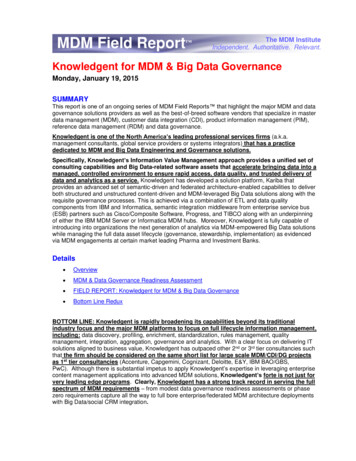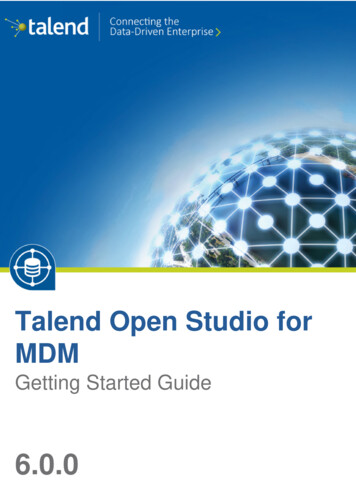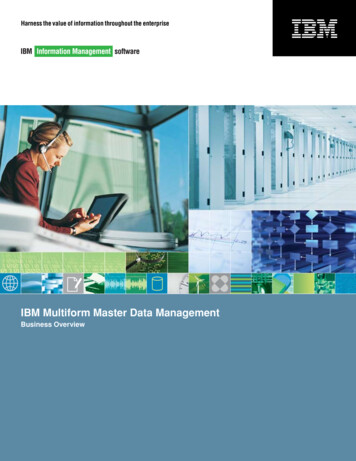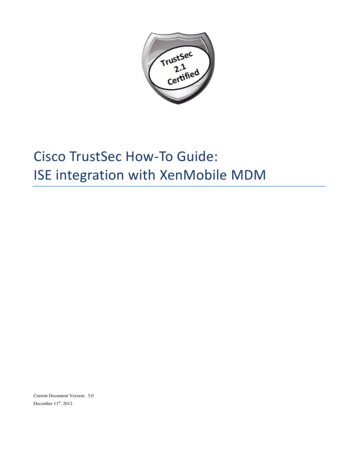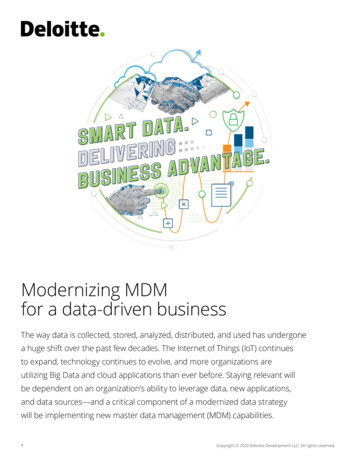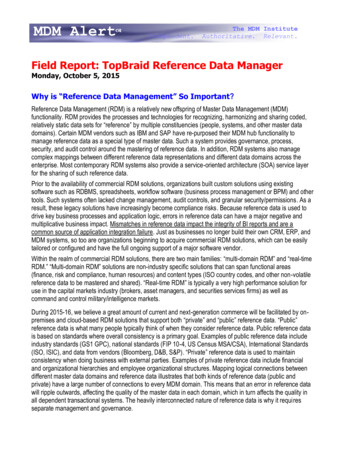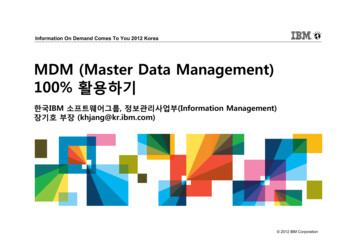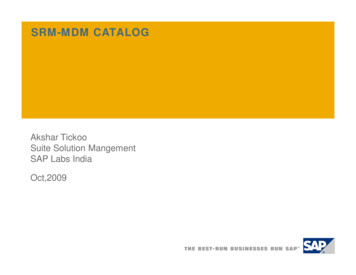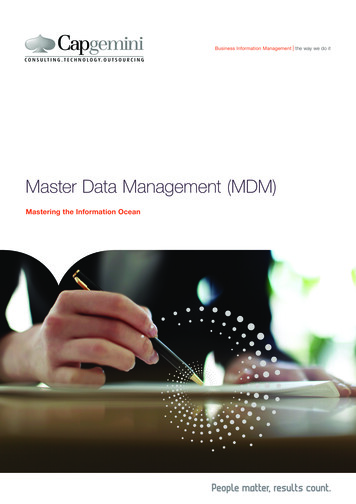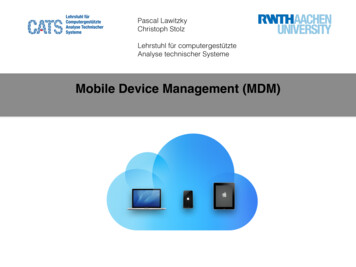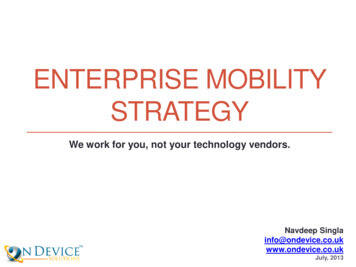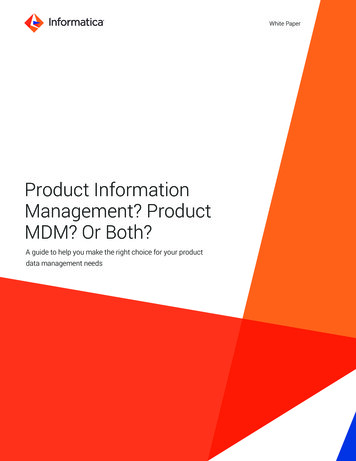
Transcription
White PaperProduct InformationManagement? ProductMDM? Or Both?A guide to help you make the right choice for your productdata management needs
ABOUT INFORMATICADigital transformation changes expectations: better service, faster delivery, with less cost.Businesses must transform to stay relevant and data holds the answers.As the world’s leader in Enterprise Cloud Data Management, we’re prepared to help you intelligentlylead—in any sector, category, or niche. Informatica provides you with the foresight to become moreagile, realize new growth opportunities, or create new inventions. With 100% focus on everythingdata, we offer the versatility needed to succeed.We invite you to explore all that Informatica has to offer—and unleash the power of data to driveyour next intelligent disruption.
Table of ContentsIntroduction.4Product Information Management .5Definition and Purpose of Product Information Management.5Key Capabilities and Business Value/Benefits of ProductInformation Management.5Drivers and Users of Product Information Management.6Product Master Data Management.6Definition and Purpose of Product Master Data Management.6Key Capabilities of Product Master Data Management.7Benefits and Business Value of Product Master Data Management .8PIM and Product MDM: A Powerful Combination . 10End-to-End Product Information Management with Informatica . 10Conclusion . 11Learn More . 113
IntroductionRemaining competitive while delivering exceptional customer experience across anytouchpoint requires more than ever an agile, scalable, and flexible solution for trusted andrelevant product data.As data volumes explode, business models change, and new sales channels emerge,having a trusted product data is more crucial than ever before.Organizations across industries have recognized product data as a strategic asset at theexecutive level. The initiative for a master data or product information management (PIM)strategy is no longer driven by IT alone. Chief Information Officers (CIOs), Chief Data Officers(CDOs), Chief Marketing Officers (CMOs), and other MarTech and Digital Marketing roles arebecoming the main executive sponsors for Master Data Management (MDM) solutions. Theyacknowledge the role of MDM and PIM to drive business value across the entire organization.They recognize the importance of these technologies for a successful data-driven digitaltransformation strategy.The Product Information Management market is estimated to grow to USD 15.78 billion by2021 with a CAGR of 25.3%.1 The master data management market size is projected toUSD 22.0 billion by 2023, at a CAGR of 18.3% from 2018 to 2023. The major factors drivingthe market include the increasing use of data quality tools for data management and the risingneed for compliance.2This increase in investment in and attention to master data, means many organizations are nowchallenged to choose the right strategy for creating a single view of trusted master data. In thearea of product master data management, this choice is leading to confusion. Specifically, thedifference between Product Master Data Management (Product MDM), and Product InformationManagement (PIM) technologies on the surface appears subtle.This paper strives to outline the difference between PIM and Product MDM. It also elaborateswhen you would choose one solution over the other and when to leverage the power ofthe .html4
Product Information ManagementDefinition and PurposeA Product Information Management (PIM) is a business application that centralizes themanagement of product data and digital assets and streamlines collaborative data enrichment.It helps standardize the increasingly complex demands of product content and syndicatestrusted, enriched and high-quality product information to sales and marketing channels.PIM improves cross-functional collaboration, streamlines critical workflows, and enablescustomer/sales opportunities to surface that otherwise would have been hidden by disconnected,poor-quality product data.It is a master-data fueled, process-driven application for collaboration on product content,designed for business users to enjoy a seamless experience from a role- and task-based easy-touse UI.An enterprise-scale PIM solution should be built on top of a data platform with a prebuiltdata model, data quality rules, business process management workflows, and a configurable,business-user-friendly UI. It should provide out-of-the-box, prebuilt data models, processes, andtemplates for faster time to value, which would compare favorably to a more DIY configurationprocess—and reduce implementation time from months to weeks.Figure 1: Typical data workflow of a PIM solutionKey Capabilities and Business Value/BenefitsThe main objectives of a PIM solution are: Streamline collaboration on product content, both internally and externally(with partners, suppliers ) Automate product information management and approval workflows Speed up time to market for new products Improve omnichannel capabilities Deliver engaging product experience across all touchpoints Publish consistent, relevant, and localized product content5
Fuel any channel with the right product information Expand the reach of sales and marketing into new channels Increase sales through rich and complete product information and digital assets engaging customer experience and loyalty thanks to trusted and relevant product content improved up-sell and across-sell opportunities higher conversion rates and margins Securely exchange product data via data poolsDrivers and UsersTypically, the need for a PIM solution is driven by the sales or marketing organization. Thisdemand arises as these divisions find they cannot adequately scale in their publication ofincreasingly complex content across the ever-increasing number of sales and marketingchannels they are required to support.PIM users are normally performing a function directly related to a sales or marketing process.It will typically support a large number on internal and external (agency) users across a broadrange of sales & marketing roles.With its strong focus on collaborative workflows, PIM allows multiple stakeholders to authora comprehensive set of product attributes needed by the business.Depending on the industry, the product attributes you manage changes: For retailers, these are typically sales and marketing attributes needed to bring a productto market For manufacturers and distributors, it is attributes for supporting logistics, master catalogs,and supplier/reseller networksFinally, once product data is completely authored, PIM syndicates or exports that data to otherconsuming systems or digital touch points such as ecommerce, e-marketplaces, point-of-sale(POS) systems, print, data pools, and more.Product Master Data ManagementDefinition and PurposeProduct Master Data Management (Product MDM) is the glue that binds an organization’ssystems and information together. Mastering product data with MDM provides a singlesource of truth—based on trusted, accurate, complete product data—for any data-drivendigital transformation: marketing and sales operations, omnichannel retailing, supply chainoptimization, compliance initiatives, and more. The primary purpose of Product MDM is to createrelationships—between products, customers, vendors, employees, households, locations, and thelike—and fuel analytical and operational business applications. Product data is managed withinan MDM system just like other business-critical data, with the intention of understanding thecomplete number and type of relationships.6
Key CapabilitiesWith Product MDM, you can locate, access, and utilize trusted data exactly when and where it’sneeded. To be able to support the end-to-end requirements of trusted product data, it shouldinclude the data quality, data integration, business process management, and data securitycapabilities that will enable you to: Acquire product, supplier or customer and other data quickly, no matter its source(on-premises, in the cloud, or from third parties) Gain visibility into data, relationship patterns, and variations—and make anynecessary corrections Easily enrich master data records with data from external providers Create a trusted view and securely deliver product data for both analytical and operationaluse casesProduct MDM has a broader scope than a specific department or types of users. The recognitionof a need for Product MDM could come from multiple different places within an organization.Roles who will recognize this need are typically trying to consolidate data across differentfunctional or regional divisions in an organization. Often the need is initially identified by IT,as they are frequently the ones who get the increasing requests to collect, cleanse, andcross-reference product data.Business users express the need for Product MDM using different terminology, all revolvingaround poor product data quality, and low trust in any figures associated with product data(sales, inventory, forecast, profitability, etc.).Product MDM spans multiple business objectives, departments, and lines of businessesacross the organization. It helps organizations improve business operations by removing datainconsistencies that can have serious impact to the business.Figure 2: Typical steps and processes of a Master Data Management solution7
Benefits and Business Value Access a trusted 360 -view of product data across the organization Avoid product launch delays Improve supply chain efficiencies Enable rapid supply chain traceability Stop lost revenue due to out-of-stocks Reduce customer defection because of poor service Reduce inventory levels Enable rich reporting and analytics environments to deliver informed decisions Consolidate product data from different systems Clear relationships (raw material and supplier; finished goods and sales regions) Achieve maximum ROI from M&As by streamlining corporate data consolidation to realizesynergies more quickly Use accurate product data across the enterprise for your analytics, big and small, for betteropportunity identification and increased value Boost business efficiency and IT performance by automating data profiling, discovery,cleansing, standardizing, enriching, matching, and merging in a single central repository Share and manage product master data strategically and securely across functions,channels, lines of business, regions, and applications8
Comparison Table: PIM vs. Product MDMThe path to value should be based on the current most pressing business challenges: Whatbusiness challenge do you want to address by implementing a solution to better manageproduct data? This table highlights the typical business value delivered by each solution.Product Information Management (PIM)Product MDMWhat’s your primaryuse case?Author product data to publish to ecommerceweb sites, print publishing systems andmulti-domain MDMMaster product data tocreate relationships betweenproducts, customers, vendors,households etc. and send tobusiness applicationsWhat data domains toyou want to manage?Primarily product domainMultiple domains built aroundproduct data. Typical domainsinclude Customer, Supplier,Location, etc.How many attributesdo you need tomanage?Hundreds of product attributes (e.g. color, size,style, price, packaging, reviews, images, etc.)Dozens of product attributesthat help identify a productuniquely (e.g. SKU)What are yourexpectations in termsof product dataauthoring?Business application for process-drivenworkflows and collaboration across teams(internal and external) to acquire, author,manage product data with role-and task-baseduser interfaceSmall amount of changes orproduct data authoring doneby small set of users, typicallydata stewardsWhat are your mainbusiness objectives? Manage heavy authoring of Master Data withdetailed workflow requirements, includingmass edit authoring/mass data management.This ensures consistency, control, and qualityin the ongoing maintenance and use ofthis information Manage a single, trustedview of products Manage digital assets and other unstructureddata (Manuals, User Guides, MarketingCollateral, etc.) related to their products Organize product data into product datacatalogs with one-to-multiple hierarchies toclassify/categorize products Manage external partners (Suppliers/Vendors/Manufacturers, Retailers, etc.) witha self-service portal to upload and/or updateproduct data Gain insight by relatingproduct to other datadomains (Customer, Supplier,Location, etc.) in one-tomultiple hierarchies, aswell as product-to-productrelationships Provide real-time access toproduct data for operationalsystems and enterpriseanalytics Manage product master data received frommultiple source systems (PLM, Data Pools,Supplier Portal, ERPs, MDM etc.) Manage product data syndication to multipleinternal or market facing channels andsystems (eCommerce, e-marketplaces,POS, Print, Mobile, Social, Data Pools, etc.)How is the systemused when it comesto management ofthe data?Single Source of Truth for Product AuthoringSingle Source of Truthacross multiple versionsof Product/PackageRegulatory complianceAutomate and streamline the secure exchangeproduct information via data pools, like theGlobal Data Synchronization Network (GDSN)within PIM to support regulatory compliance,e.g., EU 1169 for Consumer goods (PIM)Reduce the cost of complianceby having a source oftrusted product data readilyavailable, e.g. IDMP and farmto fork (MDM)9
PIM and Product MDM: A Powerful CombinationIn some cases, organizations decide to leverage both PIM and Product MDM. They may start withone solution and then add the other, since they realize that to support their use case and futuremaster data strategy, they will need a combination of both capabilities.In this case, Product MDM and PIM will enable a product master data ecosystem that combinesthe capabilities and business values listed earlier in this guide.PIM will serve as the business application for collaboration on product authoring, syndicatingdata to external systems and sales channels, but can also feed the MDM with accurate productcontent, so it maintains the Product Golden Record. MDM can also complete the part of materialdata mastering (for example). MDM serves as the foundation to hierarchy, and enables reporting,analytics, and internal system processes.MDM will allow analyzing how many products the company sells, while PIM can serve as acollaborative product content management platform with more details about the products,variants, and assortments.There is one key concept to remember when working with MDM and PIM solutions in tandem: Data should only be included in an MDM solution if there is a need to share the data broadlyacross multiple systems (e.g. internal, analytical, external, supply chain, etc.)With this concept in mind, you can accept that some of the product data will have its source and‘golden record’ outside of MDM. Specifically, the PIM system becomes the golden record for alarge portion of the sales and marketing data that is primarily fueling mostly external channels.This is similar to a PLM system being the golden record for a bill of material.End-to-End Product Information Management With InformaticaInformatica offers a PIM solution called MDM–Product 360 and a Product MDM solution calledInformatica Intelligent Multidomain MDM.Both MDM–Product 360 and Product MDM will deliver measurable business value. Depending onthe use case, you may need a combination of both to cover the full end-to-end information valuechain requirements from sourcing to consumption.An integrated approach that is based on Informatica’s Intelligent Data Platform with fullmultidomain MDM, PIM, Business Process Management (BPM) and Data Quality (DQ) capabilitiessupports a long-term data-driven digital transformation strategy. It ensures data accuracy andtransparency across customers, consumers, suppliers, locations and systems.The high-level reference architecture shows how the MDM and PIM can work together.10
Figure 3: High-Level architecture with combined MDM and PIM functionalitiesConclusionCross referencing the typical value delivery from each solution with your challenges should giveyou some initial guidance as to which technology (or combination thereof) will provide you withthe most immediate, measurable business value. And of course, this guide is not meant to bea substitute for an individual assessment of how well each technology will deliver the expectedvalue in your organization.The delivery of high-quality product data should be seen as a journey, delivered in multiple stagesor projects—starting small and growing fast. A vision of the big picture (to give you an ideaof whether you might ultimately need both technologies) along with good communication ofintermediate business value delivered is crucial to the success of this journey.Learn MoreTo discover more about both Product 360 and Multidomain MDM, you can read our brochure,download a solution brief, or contact us.Worldwide Headquarters 2100 Seaport Blvd., Redwood City, CA 94063, USAPhone: 650.385.5000, Toll-free in the US: 1.800.653.3871IN09 1219 03755 Copyright Informatica LLC 2019. Informatica, and the Informatica logo are trademarks or registered trademarks of Informatica LLC in the United States and other countries. A current list ofInformatica trademarks is available on the web at https://www.informatica.com/trademarks.html. Other company and product names may be trade names or trademarks of their respective owners.The information in this documentation is subject to change without notice and provided “AS IS” without warranty of any kind, express or implied.
Product Master Data Management Definition and Purpose Product Master Data Management (Product MDM) is the glue that binds an organization's systems and information together. Mastering product data with MDM provides a single source of truth—based on trusted, accurate, complete product data—for any data-driven
